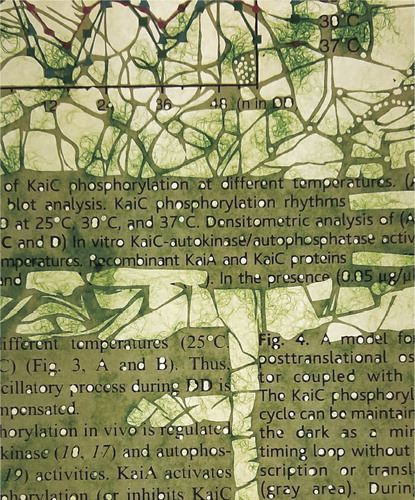Culturing <Paper>cut (since 2013) is a biological art project that deals with different modes of representation in scientific and artistic practices by materially staging live interactions between human and non-human agencies: paper cut-outs from one of my own research articles describing the behaviour of photosynthetic cyanobacteria serve as a base for materially growing cultures of these bacteria with complex patterns onto the remaining scientific paper, thus ‘hacking’ the scientific authority that analysed them.
During education, students of the natural sciences are systematically told that the use of the first person should be avoided in scientific articles in order to ensure ‘objectivity’ as a norm – the opposite is true for art students. In reality, however, when scrutinizing such papers carefully, one finds that they are not devoid of ‘subjective’ expressions at all. Being both a scientific and artistic practitioner myself, my aim is to critically reconsider the very status of the scientific research article, and to aesthetically deconstruct and transform its presuppositions.
Since my own research is concerned with the discovery of genetic mechanisms of bacterial biological clocks and their reconstitution in vitro, I chose one of my articles on the physiology of aquatic cyanobacteria, prokaryotic bacteria, which developed oxygen-evolving photosynthesis, and – self-critically – tracked down subjective expressions such as ‘interestingly’, ‘quite surprisingly’, ‘we speculate’ and ‘hopefully’. Then, the cut-outs are made according to three principles: (i) in order to reveal to what extent such descriptions are included, sentences adopting a first person or subjective position are removed, leaving rectangular shapes in the paper. (ii) Important figures and graphs that visually render biological phenomena are intentionally left intact, whereas I consider textual interpretation of those figures to be just footnotes to them. (iii) On the contrary, patterns, which refer to organic shapes or imagery of life, are cut. In addition, I also punch out circular, enclosed dots in alphabetical letters – as a remembrance of the typical behaviour of bored students in class (as I was), but also referring to a traditional paper-cutting craft called Ise katagami to make the most stylish finely cut paper stencils in Japan.
Then, in order to grow bacteria onto the cut-out sections, the paper snippets first need to be sterilized before being transferred onto solid culture media in rectangular Petri dishes, and further being inoculated with cyanobacteria collected from a neighbouring pond. Placed onto the remaining scientific paper, the formerly analysed research target now gradually grows and superimposes itself onto the research paper, while bacteria move and grow differently on solid media and the cut-outs. They give rise to ‘surprisingly’ complicated collective behaviour and generate species and environment-specific morphological patterns, most of which have not been studied yet and that show a kind of ecological wisdom bacteria possess to adapt to their environmental niches.
In this sense, Culturing <Paper>cut not only addresses questions of how science and human cultural activity describe and represent biological systems, but also how different biological systems themselves represent one another on different scales: As my scientific research papers (Tomita et al. 2005, Kawamoto et al. 2020) show, the internal clock to keep 24-hour-period cycles in bacteria, comparable to the human body’s circadian clock responsible for endogenous sleep/wake cycles, is a biological phenomenon that reproduces, represents or ‘hacks’ the rotation cycle of the Earth in bodies (ranging from molecular, cellular, individual to population dynamics). It is an internal representation of the outside world, which I have been able to reproduce in an in vitro experiment by reconstituting enzymatic reaction oscillating within a period of 24 hours by simply incubating three proteins encoded by the clock genes in a test tube (Nakajima et al. 2005). The outer world is inevitably imprinted as much into the clock proteins of bacteria as into the clock cells of our own human bodies. This continuous interaction between the outside and the inside is necessary for living systems to adapt to the environment. My artwork makes these micro and macroscopic loops tangible.
REFERENCES
- Kawamoto, Naohiro, Ito, Hiroshi, Tokuda Isao T. and Iwasaki, Hideo (2020) ‘Damped circadian oscillation in the absence of KaiA in Synechococcus‘, Nature Communications 11(1), 2,242. doi: 10.1038/s41467-020-16087-x
- Nakajima, Masato, Imai, Keiko, Ito, Hiroshi, Nishiwaki, Taeko, Murayama, Yoriko, Iwasaki, Hideo, Oyama, Tokitaka and Kondo, Takao (2005) ‘Reconstitution of circadian oscillation of cyanobacterial KaiC phosphorylation in vitro’, Science 308(5,720): 414–15. doi: 10.1126/science.1108451
- Tomita, Jun, Nakajima, Masato, Kondo, Takao and Iwasaki, Hideo (2005) ‘No transcription–translation feedback in circadian rhythm of KaiC phosphorylation’, Science 307(5,707): 251–4. doi: 10.1126/science.1102540


